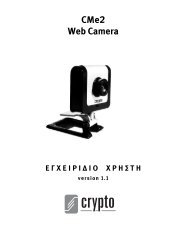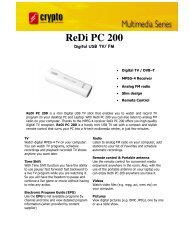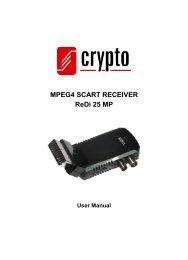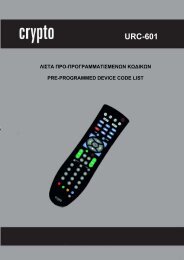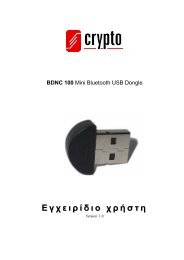AirData 54 Plus S2 USB
AirData 54 Plus S2 USB
AirData 54 Plus S2 USB
Create successful ePaper yourself
Turn your PDF publications into a flip-book with our unique Google optimized e-Paper software.
<strong>AirData</strong> <strong>54</strong> <strong>Plus</strong> <strong>S2</strong> <strong>USB</strong> User Manual<br />
ISM Band: Industrial, Scientific and Medical Band is the 2.4 – 2.483 GHz frequency band.<br />
LED: Light Emitting Diode, an electronic device that lights up when electricity is passed<br />
through it.<br />
MAC Address: Media Access Control Address is a unique HEX number assigned by the<br />
manufacturer to any Ethernet networking device.<br />
Node: A network junction or connection point, typically an Access Point / Router.<br />
OFDM: Orthogonal Frequency Division Multiplexing is a modulation scheme that works by<br />
dividing the communication channel into a number of sub-channels that are spaced apart at<br />
precise frequencies. This spacing provides the “orthogonality” in this technique which allows<br />
the transmitter and the receiver to communicate using a “dedicated” sub-channel. The<br />
benefits of OFDM are high spectral efficiency and resiliency to interference.<br />
Open Authentication: Open System authentication is a null authentication algorithm. Any<br />
station that requests authentication receives it. If the key that the station is using is not<br />
correct, then further communication is not possible<br />
Packet: A set of data routed between an origin and a destination in a network.<br />
Preamble Type: A preamble is a signal used in network communications to synchronize the<br />
transmission timing between two or more systems.<br />
RADIUS: Remote Authentication Dial-In User Service is an authentication and accounting<br />
system used by many Internet Service Providers (ISPs). When you dial in to the ISP you<br />
must enter your username and password. This information is passed to a RADIUS server,<br />
which checks that the information is correct, and then authorizes access to the ISP system.<br />
RTS: Request To Send is a signal sent from the transmitting station to the receiving station<br />
requesting permission to transmit.<br />
Shared Key Authentication: When Shared Key authentication is enabled, the Access Point /<br />
Router sends a packet to the client. The client uses a secret key in order to encode the<br />
packet and retransmits the encoded information back to the Access Point / Router. If the<br />
packet is correctly encoded then the client is authenticated.<br />
75



